Deck 16: Financing Project Development
سؤال
سؤال
سؤال
سؤال
سؤال
سؤال
سؤال
سؤال
سؤال
سؤال
سؤال
سؤال
سؤال
سؤال
سؤال
سؤال
سؤال
سؤال
سؤال
سؤال

فتح الحزمة
قم بالتسجيل لفتح البطاقات في هذه المجموعة!
Unlock Deck
Unlock Deck
1/20
العب
ملء الشاشة (f)
Deck 16: Financing Project Development
1
Review Concept Box 16.2. The investor-developer would not be comfortable with a 7.8 percent return on cost because the "margin for error" is too risky. If construction costs are higher or rents are lower than anticipated, the project may not be feasible.
a. Based on the fact that the project appears to have 9,360 square feet of surface area in excess of zoning requirements, the developer could make an argument to the planning department for an additional 10 units, 250 units in total, or 25 units per acre. How would this affect financial feasibility What could be included in such an argument Why would a public regulatory institution be interested in increasing density to 25 units per acre Why not
b. Instead of ( a ), suppose the developer could build a 240-unit luxury apartment complex with a cost of $83,000 per unit. What would such a project have to rent for (per square foot) to make an 8 percent return on total cost What risk factors would the developer have to consider
(For Reference Concept Box 16.2)
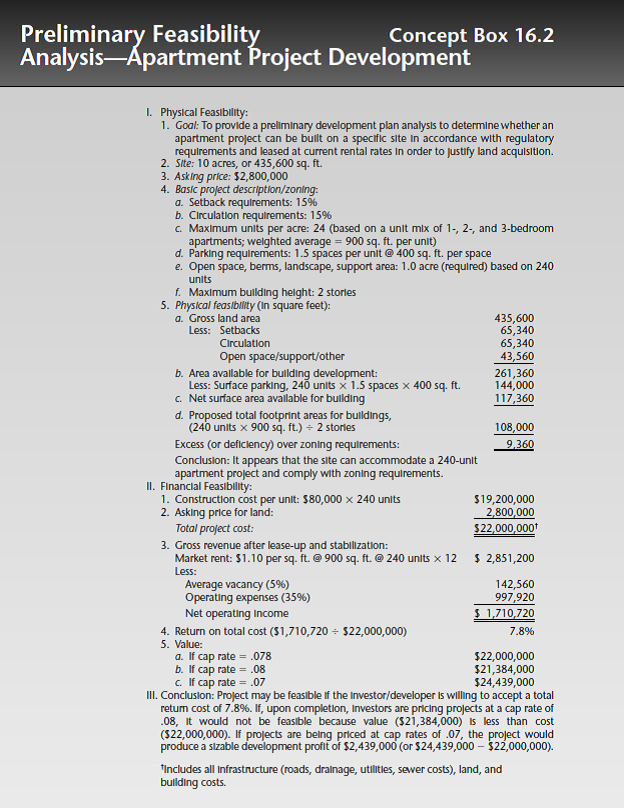
a. Based on the fact that the project appears to have 9,360 square feet of surface area in excess of zoning requirements, the developer could make an argument to the planning department for an additional 10 units, 250 units in total, or 25 units per acre. How would this affect financial feasibility What could be included in such an argument Why would a public regulatory institution be interested in increasing density to 25 units per acre Why not
b. Instead of ( a ), suppose the developer could build a 240-unit luxury apartment complex with a cost of $83,000 per unit. What would such a project have to rent for (per square foot) to make an 8 percent return on total cost What risk factors would the developer have to consider
(For Reference Concept Box 16.2)

a.
If the planning department request for an additional 10 units then it would affect the return. Therefore, it is required to first calculate the return on total cost if there are 250 units instead of 240 units as shown below:
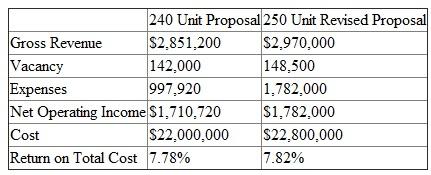 The return on total cost of 250 units has increased to 7.82% from 7.78% of 240 units. Thus according to this return this project is highly feasible.
The return on total cost of 250 units has increased to 7.82% from 7.78% of 240 units. Thus according to this return this project is highly feasible.
The land cost per unit of 240 unit proposal is (2,800,000/240) = $11,667 and the land cost per unit of 250 unit proposal is (2,800,000/250) = $11,200. Thus due to decrease in cost the 250 unit proposal becomes more feasible. The public regulatory institution is interested in increasing the density to 25 units per acre in order to increase its property tax revenues or to develop more housing in that area. However, this practice it considered as unfair for those people who were promised of projects with lower densities. Apart from this, if the developer increases the density then it might result in increase in traffic.
b.
If the developer wants 8% return on cost then its NOI will be calculated and shown below:
 Now lets calculate the rent based on NOI as shown below:
Now lets calculate the rent based on NOI as shown below:
 The annual rent is $3,029,333.
The annual rent is $3,029,333.
Now it is required to calculate the per month rent as shown below:
 Thus per month rent comes out to be $1,026 which has been increased from $990. The developer would have to consider such factors like suitability of the project in that area and compare rents in that area to provide luxury units to people.
Thus per month rent comes out to be $1,026 which has been increased from $990. The developer would have to consider such factors like suitability of the project in that area and compare rents in that area to provide luxury units to people.
If the planning department request for an additional 10 units then it would affect the return. Therefore, it is required to first calculate the return on total cost if there are 250 units instead of 240 units as shown below:
 The return on total cost of 250 units has increased to 7.82% from 7.78% of 240 units. Thus according to this return this project is highly feasible.
The return on total cost of 250 units has increased to 7.82% from 7.78% of 240 units. Thus according to this return this project is highly feasible.The land cost per unit of 240 unit proposal is (2,800,000/240) = $11,667 and the land cost per unit of 250 unit proposal is (2,800,000/250) = $11,200. Thus due to decrease in cost the 250 unit proposal becomes more feasible. The public regulatory institution is interested in increasing the density to 25 units per acre in order to increase its property tax revenues or to develop more housing in that area. However, this practice it considered as unfair for those people who were promised of projects with lower densities. Apart from this, if the developer increases the density then it might result in increase in traffic.
b.
If the developer wants 8% return on cost then its NOI will be calculated and shown below:
 Now lets calculate the rent based on NOI as shown below:
Now lets calculate the rent based on NOI as shown below: The annual rent is $3,029,333.
The annual rent is $3,029,333.Now it is required to calculate the per month rent as shown below:
 Thus per month rent comes out to be $1,026 which has been increased from $990. The developer would have to consider such factors like suitability of the project in that area and compare rents in that area to provide luxury units to people.
Thus per month rent comes out to be $1,026 which has been increased from $990. The developer would have to consider such factors like suitability of the project in that area and compare rents in that area to provide luxury units to people. 2
What are the sources of risk associated with project development
Risk:
Risk refers to the probability that the real return of an investment would differ from the anticipated return. It includes the chances of losing either some or the entire original amount invested. The different forms of risk can be determined by determining the standard deviation of the historical returns or the average returns of a particular investment.
Sources of risk in project development:
There are certain risks related with project development. Some of the sources of risk associated with project development are project risks and market risks. Project risks can be defined as the risks that arise on selecting a specific area to develop a property and designing the project. Market risks can be defined as the risks that arise due to sudden changes in the normal market conditions that influences the supply and demand for space.
Hence, the sources of risk in the project development are project risks and market risks.
Risk refers to the probability that the real return of an investment would differ from the anticipated return. It includes the chances of losing either some or the entire original amount invested. The different forms of risk can be determined by determining the standard deviation of the historical returns or the average returns of a particular investment.
Sources of risk in project development:
There are certain risks related with project development. Some of the sources of risk associated with project development are project risks and market risks. Project risks can be defined as the risks that arise on selecting a specific area to develop a property and designing the project. Market risks can be defined as the risks that arise due to sudden changes in the normal market conditions that influences the supply and demand for space.
Hence, the sources of risk in the project development are project risks and market risks.
3
The CEO of Kuehner Development Co. has just come from a meeting with his marketing staff where he was given the latest market study of a proposed new shopping center, Parker Road Plaza. The study calls for a construction phase of one year and an operation phase of five years. The property is to be sold at the end of the fifth year of operation.
Part I. Construction Phase :
The marketing staff has chosen a 12-acre site for the project that they believe they can acquire for $2.25 million. The initial studies indicate that this shopping center will support a floor-toarea ratio of 36.35 percent and a 92.11 percent leasable area ratio. (This means that the gross building area [ GBA ] will be 190,000 square feet, and the gross leasable area [ GLA ] will be 175,000 square feet.)
The head of Kuehner's construction division assures the CEO that construction can keep hard costs to $54 per square foot (GBA) and soft costs (excluding interest carry and all loan fees) to $4.50 per square foot (GBA). The division has decided to subcontract all of the site improvements at a total cost of $750,000.
The Shawmut Bank has agreed to provide interim financing for the project. The bank will finance all of the construction costs and site improvements at an annual rate of 13 percent plus a loan commitment fee of two points. The construction division estimates that 60 percent of the total direct cost will be taken down evenly during the first six months of the construction phase.
Kuehner expects to obtain permanent financing from the Acme Insurance Co. at an interest rate of 12 percent for 20 years with a 2.5 percent prepaid loan fee and a 10-year call. Kuehner is expected to make monthly loan payments.
A) What will be the total project cost for Parker Road Plaza (excluding loan commitment fees and interest carry) What will be the total direct costs
B) What will be the interest carry for the Parker Road Plaza project What will be the total loan amount that Kuehner must borrow (including interest carry) What will be the yield to the lender on this construction loan
C) What is the total project cost and how much equity must be put into the project each year
during the construction phase (Kuehner will fund both loan commitment fees from project equity.)
Part II. Operations and Final Sale Phase :
Kuehner estimates that it can lease Parker Road Plaza for $18.50 per square foot ( GLA ) base rent with a 3 percent overage on gross sales in excess of $200 per square foot ( GLA ). The company expects rents to increase by 5 percent per year during the lease period and tenant reimbursements to run $8 per square foot ( GLA ) and to increase at the same rate as rents. Kuehner expects to
have the shopping center 70 percent leased during the first year of operation. After that, vacancies should average about 5 percent per year. The vacancy losses should be calculated on the entire gross potential income, which includes minimum rents, percentage rents, and tenant reimbursements. Sales, which are expected to average $210 per square foot ( GLA ) for the first year of operation, should grow at 6 percent per year. The operating expenses are expected to average $14 per square foot of GLA for the first year and will increase at the same rate as the rents. Kuehner will collect an additional 5 percent of EGI as an annual management fee. The final sales price is expected to be $18.4 million and Kuehner will incur sales expenses of 2 percent. Two schedules provide necessary information about this phase of the project: (1) the gross potential income of Parker Road Plaza for the five-year operation period; and (2) the schedule of amortization and depreciation expenses for the project.
D) What cash flows would Kuehner Development Co. earn before and after taxes for Parker Road Plaza if it were operated for five years (assuming the marginal tax rate to be 28 percent for ordinary income and capital gains) What cash flows will Kuehner realize before and after taxes from the sale of the project after five years
E) Assuming that Kuehner's before-tax required rate of return is 16 percent, should the company develop Parker Road Plaza Justify your answer based on BTNPV and BTIRR.
![<strong>The CEO of Kuehner Development Co. has just come from a meeting with his marketing staff where he was given the latest market study of a proposed new shopping center, Parker Road Plaza. The study calls for a construction phase of one year and an operation phase of five years. The property is to be sold at the end of the fifth year of operation. Part I. Construction Phase : The marketing staff has chosen a 12-acre site for the project that they believe they can acquire for $2.25 million. The initial studies indicate that this shopping center will support a floor-toarea ratio of 36.35 percent and a 92.11 percent leasable area ratio. (This means that the gross building area [ GBA ] will be 190,000 square feet, and the gross leasable area [ GLA ] will be 175,000 square feet.) The head of Kuehner's construction division assures the CEO that construction can keep hard costs to $54 per square foot (GBA) and soft costs (excluding interest carry and all loan fees) to $4.50 per square foot (GBA). The division has decided to subcontract all of the site improvements at a total cost of $750,000. The Shawmut Bank has agreed to provide interim financing for the project. The bank will finance all of the construction costs and site improvements at an annual rate of 13 percent plus a loan commitment fee of two points. The construction division estimates that 60 percent of the total direct cost will be taken down evenly during the first six months of the construction phase. Kuehner expects to obtain permanent financing from the Acme Insurance Co. at an interest rate of 12 percent for 20 years with a 2.5 percent prepaid loan fee and a 10-year call. Kuehner is expected to make monthly loan payments.</strong> A) What will be the total project cost for Parker Road Plaza (excluding loan commitment fees and interest carry) What will be the total direct costs B) What will be the interest carry for the Parker Road Plaza project What will be the total loan amount that Kuehner must borrow (including interest carry) What will be the yield to the lender on this construction loan C) What is the total project cost and how much equity must be put into the project each year during the construction phase (Kuehner will fund both loan commitment fees from project equity.) Part II. Operations and Final Sale Phase : Kuehner estimates that it can lease Parker Road Plaza for $18.50 per square foot ( GLA ) base rent with a 3 percent overage on gross sales in excess of $200 per square foot ( GLA ). The company expects rents to increase by 5 percent per year during the lease period and tenant reimbursements to run $8 per square foot ( GLA ) and to increase at the same rate as rents. Kuehner expects to have the shopping center 70 percent leased during the first year of operation. After that, vacancies should average about 5 percent per year. The vacancy losses should be calculated on the entire gross potential income, which includes minimum rents, percentage rents, and tenant reimbursements. Sales, which are expected to average $210 per square foot ( GLA ) for the first year of operation, should grow at 6 percent per year. The operating expenses are expected to average $14 per square foot of GLA for the first year and will increase at the same rate as the rents. Kuehner will collect an additional 5 percent of EGI as an annual management fee. The final sales price is expected to be $18.4 million and Kuehner will incur sales expenses of 2 percent. Two schedules provide necessary information about this phase of the project: (1) the gross potential income of Parker Road Plaza for the five-year operation period; and (2) the schedule of amortization and depreciation expenses for the project. D) What cash flows would Kuehner Development Co. earn before and after taxes for Parker Road Plaza if it were operated for five years (assuming the marginal tax rate to be 28 percent for ordinary income and capital gains) What cash flows will Kuehner realize before and after taxes from the sale of the project after five years E) Assuming that Kuehner's before-tax required rate of return is 16 percent, should the company develop Parker Road Plaza Justify your answer based on BTNPV and BTIRR.](https://d2lvgg3v3hfg70.cloudfront.net/SM5992/11eb75bb_ace1_df6b_adfc_8f6f278a39ad_SM5992_00.jpg)
Part I. Construction Phase :
The marketing staff has chosen a 12-acre site for the project that they believe they can acquire for $2.25 million. The initial studies indicate that this shopping center will support a floor-toarea ratio of 36.35 percent and a 92.11 percent leasable area ratio. (This means that the gross building area [ GBA ] will be 190,000 square feet, and the gross leasable area [ GLA ] will be 175,000 square feet.)
The head of Kuehner's construction division assures the CEO that construction can keep hard costs to $54 per square foot (GBA) and soft costs (excluding interest carry and all loan fees) to $4.50 per square foot (GBA). The division has decided to subcontract all of the site improvements at a total cost of $750,000.
The Shawmut Bank has agreed to provide interim financing for the project. The bank will finance all of the construction costs and site improvements at an annual rate of 13 percent plus a loan commitment fee of two points. The construction division estimates that 60 percent of the total direct cost will be taken down evenly during the first six months of the construction phase.
Kuehner expects to obtain permanent financing from the Acme Insurance Co. at an interest rate of 12 percent for 20 years with a 2.5 percent prepaid loan fee and a 10-year call. Kuehner is expected to make monthly loan payments.
A) What will be the total project cost for Parker Road Plaza (excluding loan commitment fees and interest carry) What will be the total direct costs
B) What will be the interest carry for the Parker Road Plaza project What will be the total loan amount that Kuehner must borrow (including interest carry) What will be the yield to the lender on this construction loan
C) What is the total project cost and how much equity must be put into the project each year
during the construction phase (Kuehner will fund both loan commitment fees from project equity.)
Part II. Operations and Final Sale Phase :
Kuehner estimates that it can lease Parker Road Plaza for $18.50 per square foot ( GLA ) base rent with a 3 percent overage on gross sales in excess of $200 per square foot ( GLA ). The company expects rents to increase by 5 percent per year during the lease period and tenant reimbursements to run $8 per square foot ( GLA ) and to increase at the same rate as rents. Kuehner expects to
have the shopping center 70 percent leased during the first year of operation. After that, vacancies should average about 5 percent per year. The vacancy losses should be calculated on the entire gross potential income, which includes minimum rents, percentage rents, and tenant reimbursements. Sales, which are expected to average $210 per square foot ( GLA ) for the first year of operation, should grow at 6 percent per year. The operating expenses are expected to average $14 per square foot of GLA for the first year and will increase at the same rate as the rents. Kuehner will collect an additional 5 percent of EGI as an annual management fee. The final sales price is expected to be $18.4 million and Kuehner will incur sales expenses of 2 percent. Two schedules provide necessary information about this phase of the project: (1) the gross potential income of Parker Road Plaza for the five-year operation period; and (2) the schedule of amortization and depreciation expenses for the project.
D) What cash flows would Kuehner Development Co. earn before and after taxes for Parker Road Plaza if it were operated for five years (assuming the marginal tax rate to be 28 percent for ordinary income and capital gains) What cash flows will Kuehner realize before and after taxes from the sale of the project after five years
E) Assuming that Kuehner's before-tax required rate of return is 16 percent, should the company develop Parker Road Plaza Justify your answer based on BTNPV and BTIRR.
![<strong>The CEO of Kuehner Development Co. has just come from a meeting with his marketing staff where he was given the latest market study of a proposed new shopping center, Parker Road Plaza. The study calls for a construction phase of one year and an operation phase of five years. The property is to be sold at the end of the fifth year of operation. Part I. Construction Phase : The marketing staff has chosen a 12-acre site for the project that they believe they can acquire for $2.25 million. The initial studies indicate that this shopping center will support a floor-toarea ratio of 36.35 percent and a 92.11 percent leasable area ratio. (This means that the gross building area [ GBA ] will be 190,000 square feet, and the gross leasable area [ GLA ] will be 175,000 square feet.) The head of Kuehner's construction division assures the CEO that construction can keep hard costs to $54 per square foot (GBA) and soft costs (excluding interest carry and all loan fees) to $4.50 per square foot (GBA). The division has decided to subcontract all of the site improvements at a total cost of $750,000. The Shawmut Bank has agreed to provide interim financing for the project. The bank will finance all of the construction costs and site improvements at an annual rate of 13 percent plus a loan commitment fee of two points. The construction division estimates that 60 percent of the total direct cost will be taken down evenly during the first six months of the construction phase. Kuehner expects to obtain permanent financing from the Acme Insurance Co. at an interest rate of 12 percent for 20 years with a 2.5 percent prepaid loan fee and a 10-year call. Kuehner is expected to make monthly loan payments.</strong> A) What will be the total project cost for Parker Road Plaza (excluding loan commitment fees and interest carry) What will be the total direct costs B) What will be the interest carry for the Parker Road Plaza project What will be the total loan amount that Kuehner must borrow (including interest carry) What will be the yield to the lender on this construction loan C) What is the total project cost and how much equity must be put into the project each year during the construction phase (Kuehner will fund both loan commitment fees from project equity.) Part II. Operations and Final Sale Phase : Kuehner estimates that it can lease Parker Road Plaza for $18.50 per square foot ( GLA ) base rent with a 3 percent overage on gross sales in excess of $200 per square foot ( GLA ). The company expects rents to increase by 5 percent per year during the lease period and tenant reimbursements to run $8 per square foot ( GLA ) and to increase at the same rate as rents. Kuehner expects to have the shopping center 70 percent leased during the first year of operation. After that, vacancies should average about 5 percent per year. The vacancy losses should be calculated on the entire gross potential income, which includes minimum rents, percentage rents, and tenant reimbursements. Sales, which are expected to average $210 per square foot ( GLA ) for the first year of operation, should grow at 6 percent per year. The operating expenses are expected to average $14 per square foot of GLA for the first year and will increase at the same rate as the rents. Kuehner will collect an additional 5 percent of EGI as an annual management fee. The final sales price is expected to be $18.4 million and Kuehner will incur sales expenses of 2 percent. Two schedules provide necessary information about this phase of the project: (1) the gross potential income of Parker Road Plaza for the five-year operation period; and (2) the schedule of amortization and depreciation expenses for the project. D) What cash flows would Kuehner Development Co. earn before and after taxes for Parker Road Plaza if it were operated for five years (assuming the marginal tax rate to be 28 percent for ordinary income and capital gains) What cash flows will Kuehner realize before and after taxes from the sale of the project after five years E) Assuming that Kuehner's before-tax required rate of return is 16 percent, should the company develop Parker Road Plaza Justify your answer based on BTNPV and BTIRR.](https://d2lvgg3v3hfg70.cloudfront.net/SM5992/11eb75bb_ace1_df6b_adfc_8f6f278a39ad_SM5992_00.jpg)
Use spreadsheet for the required computation. Enter given values and formulas in the spreadsheet as shown in the image below. Answers are highlighted in 'Orange'.
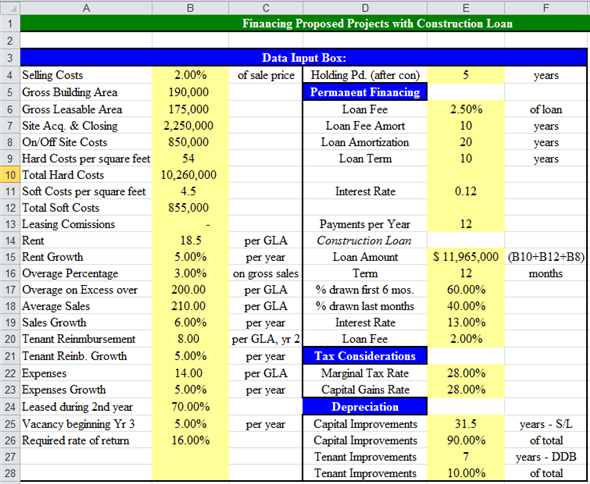 Obtained results are shown below.
Obtained results are shown below.
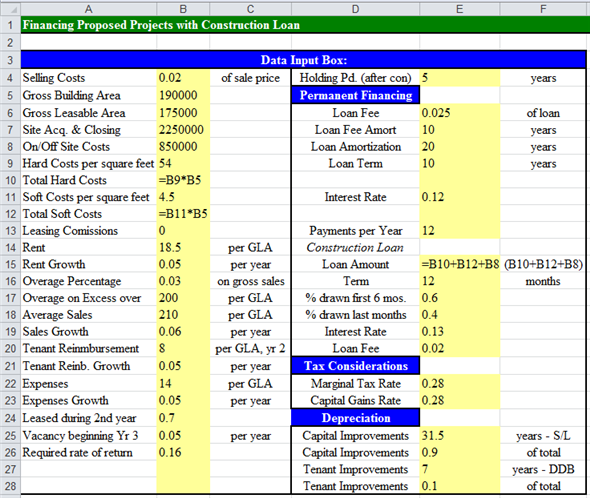 a.
a.
Compute the total project costs and total direct costs as follows. Enter given values and formulas in the spreadsheet as shown in the image below.
 Obtained results are shown below.
Obtained results are shown below.
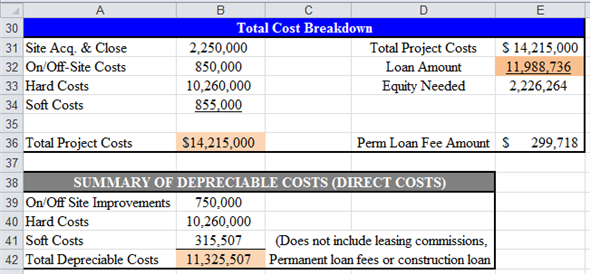 Thus, the total project and total direct costs are
Thus, the total project and total direct costs are
 and
and
 respectively.
respectively.
b.
Compute the interest carry, total loan amount to be borrowed, and yield to lender. Enter given values and formulas in the spreadsheet as shown in the image below.
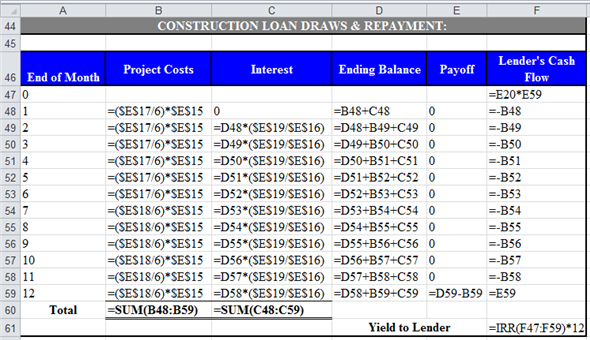

 Obtained results for interest carry, total loan amount to be borrowed, and yield to lender are as follows:
Obtained results for interest carry, total loan amount to be borrowed, and yield to lender are as follows:
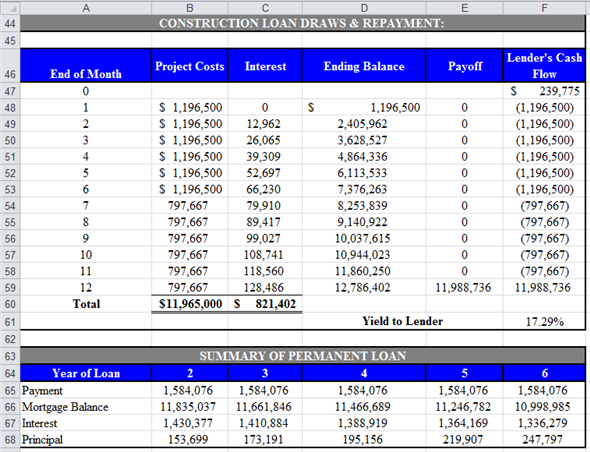 c.
c.
Compute amount of equity to be put into each year of construction phase. Enter given values and formulas in the spreadsheet as shown in the image below.
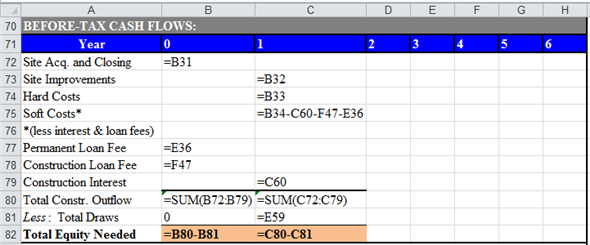 Obtained results are shown below.
Obtained results are shown below.
 d.
d.
Compute before and after tax operating cash flows. Enter given values and formulas in the spreadsheet as shown in the image below.
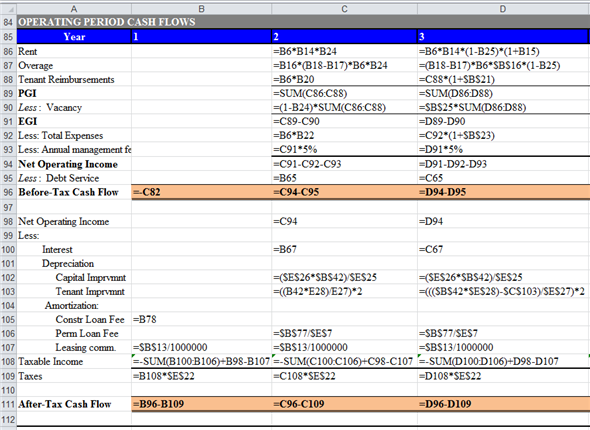
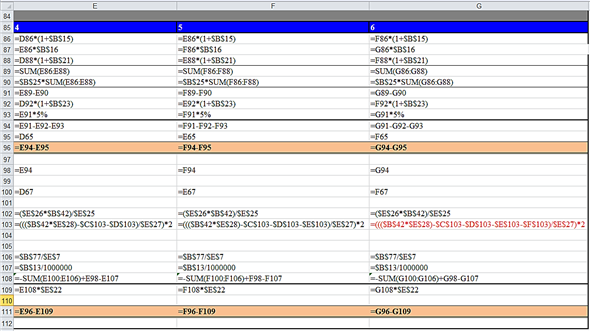 Obtained results are as follows:
Obtained results are as follows:
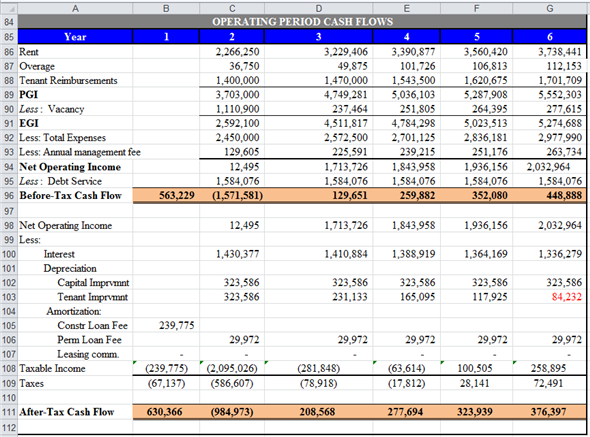 Compute before and after tax cash flows from sale. Enter given values and formulas in the spreadsheet as shown in the image below.
Compute before and after tax cash flows from sale. Enter given values and formulas in the spreadsheet as shown in the image below.
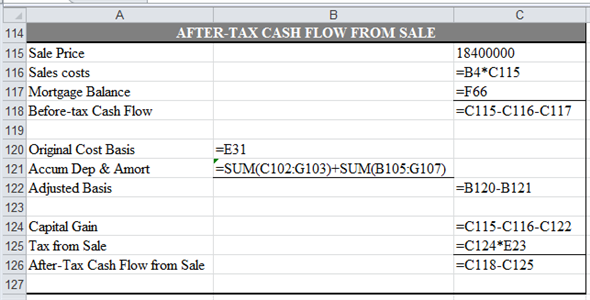 Obtained results are as follows:
Obtained results are as follows:
 Thus, the after-tax cash flow from sale is
Thus, the after-tax cash flow from sale is
 .
.
e.
Compute before and after tax operating cash flows as per given 'Pro Forma Operating Statement'. Enter given values and formulas in the spreadsheet as shown in the image below.
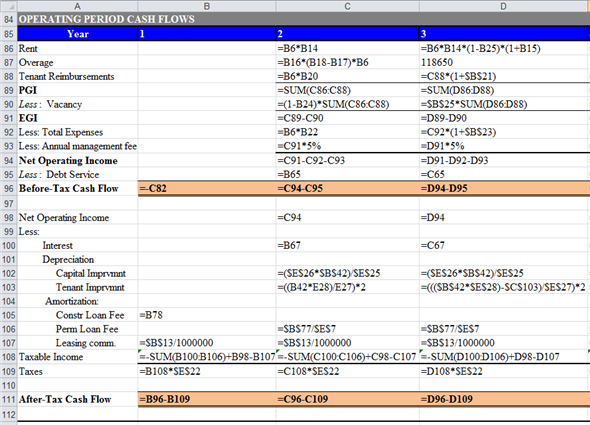
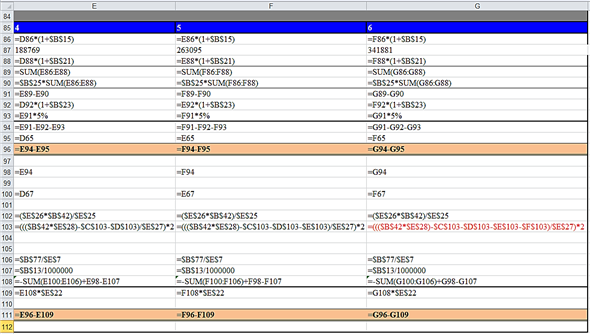 Obtained results are as follows:
Obtained results are as follows:
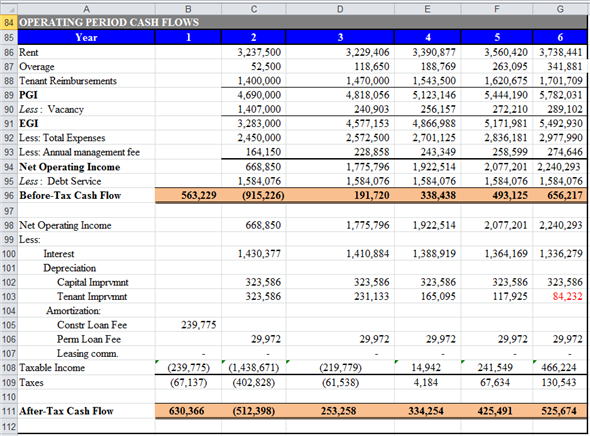 Compute before and after tax cash flows from sale. Enter given values and formulas in the spreadsheet as shown in the image below.
Compute before and after tax cash flows from sale. Enter given values and formulas in the spreadsheet as shown in the image below.
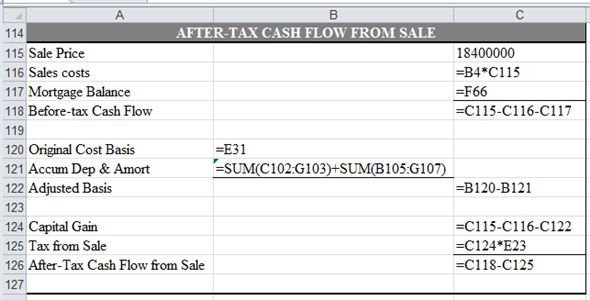 Obtained results are as follows:
Obtained results are as follows:
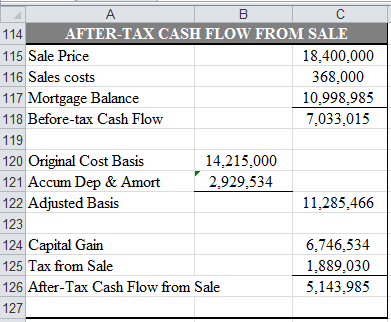 Thus, the after-tax cash flow from sale is
Thus, the after-tax cash flow from sale is
 .
.
Compute BTCF IRR (before Tax Cash Flow Internal Rate of Return) and BT NPV (before Tax Net Present Value). Enter given values and formulas in the spreadsheet as shown in the image below.
 Obtained results are as follows:
Obtained results are as follows:
 Thus, the BTCF IRR and BT NPV are
Thus, the BTCF IRR and BT NPV are
 and
and
 respectively.
respectively.
The presented Pro Forma Statement is based on the 100% leasing and it ignores the losses from vacancy. Thus, the obtained BT IRR and BT NPV are not appropriate to take decision to accept or reject the project.
 Obtained results are shown below.
Obtained results are shown below. a.
a.Compute the total project costs and total direct costs as follows. Enter given values and formulas in the spreadsheet as shown in the image below.
 Obtained results are shown below.
Obtained results are shown below.  Thus, the total project and total direct costs are
Thus, the total project and total direct costs are and
and respectively.
respectively.b.
Compute the interest carry, total loan amount to be borrowed, and yield to lender. Enter given values and formulas in the spreadsheet as shown in the image below.


 Obtained results for interest carry, total loan amount to be borrowed, and yield to lender are as follows:
Obtained results for interest carry, total loan amount to be borrowed, and yield to lender are as follows: c.
c. Compute amount of equity to be put into each year of construction phase. Enter given values and formulas in the spreadsheet as shown in the image below.
 Obtained results are shown below.
Obtained results are shown below. d.
d.Compute before and after tax operating cash flows. Enter given values and formulas in the spreadsheet as shown in the image below.

 Obtained results are as follows:
Obtained results are as follows:  Compute before and after tax cash flows from sale. Enter given values and formulas in the spreadsheet as shown in the image below.
Compute before and after tax cash flows from sale. Enter given values and formulas in the spreadsheet as shown in the image below. Obtained results are as follows:
Obtained results are as follows: Thus, the after-tax cash flow from sale is
Thus, the after-tax cash flow from sale is .
.e.
Compute before and after tax operating cash flows as per given 'Pro Forma Operating Statement'. Enter given values and formulas in the spreadsheet as shown in the image below.

 Obtained results are as follows:
Obtained results are as follows: Compute before and after tax cash flows from sale. Enter given values and formulas in the spreadsheet as shown in the image below.
Compute before and after tax cash flows from sale. Enter given values and formulas in the spreadsheet as shown in the image below.  Obtained results are as follows:
Obtained results are as follows: Thus, the after-tax cash flow from sale is
Thus, the after-tax cash flow from sale is .
.Compute BTCF IRR (before Tax Cash Flow Internal Rate of Return) and BT NPV (before Tax Net Present Value). Enter given values and formulas in the spreadsheet as shown in the image below.
 Obtained results are as follows:
Obtained results are as follows: Thus, the BTCF IRR and BT NPV are
Thus, the BTCF IRR and BT NPV are and
and respectively.
respectively.The presented Pro Forma Statement is based on the 100% leasing and it ignores the losses from vacancy. Thus, the obtained BT IRR and BT NPV are not appropriate to take decision to accept or reject the project.
4
What are some development strategies that many developers follow Why do they follow such strategies

فتح الحزمة
افتح القفل للوصول البطاقات البالغ عددها 20 في هذه المجموعة.
فتح الحزمة
k this deck
5
As a financial advisor for the Spain Development Co., you have been given the construction and marketing studies for the proposed Timbercreek office project. Several potential sites have been selected, but a final decision has not been made. Your manager needs to know how much she can afford to pay for the land and still manage to return 16 percent on the entire project over its lifetime.
The strategic plan calls for a construction phase of one year and an operation phase of five years, after which time the property will be sold. The marketing staff says that a 1.3-acre site will be adequate because the initial studies indicate that this site will support an office building with a gross leasable area ( GLA ) of 26,520 square feet. The gross building area ( GBA ) will be 31,200 square feet, giving a leasable ratio of 85 percent. The marketing staff further assures you that the space can be rented for $19 per square foot. The head of the construction division maintains that all direct costs (excluding interest carry and all loan fees) will be $2.4 million.
The First Street Bank will provide the construction loan for the project. The bank will finance all of the construction costs, site improvements, and interest carry at an annual rate of 13 percent plus a loan origination fee of 1.5 points. The construction division estimates that the direct cost draws will be taken down in six equal amounts commencing with the first month after close. The permanent financing for the project will come at the end of the first year from the Reliable Co. at an interest rate of 11.5 percent with a 4 percent prepaid loan fee. The loan has an eight-year term and is to be paid back monthly over a 25-year amortization schedule. No financing fees will be included in either loan amount. Spain will fund acquisition of the land with its own equity.
Spain expects tenant reimbursements for the project to be $3.25 per square foot and the office building to be 75 percent leased during the first year of operation. After that, vacancies should average about 5 percent of GPI per year. Rents, tenant reimbursement, and operating expenses are expected to increase by 3 percent per year during the lease period. The operating expenses are expected to be $9.50 per square foot. The final sales price is based on the NOI in the sixth year of the project (the fifth year of operation) capitalized at 9.5 percent. The project will incur sales expenses of 4 percent. Spain is concerned that it may not be able to afford to pay for the land and still earn 16 percent (before taxes) on its equity (remember that the land acquisition cost must be paid from Spain's equity).
To consider project feasibility,
a. Estimate the construction draw schedule, interest carry, and total loan amount for improvements. Determine total project cost (including fees) less financing and the equity needed to fund improvements.
b. Estimate cash flows from operations and eventual sale.
c. Establish whether a positive or negative NPV exists by discounting equity cash inflows and outflows in ( b ).
d. What does the NPV mean in this case If the asking price of the land were $195,000, would this project be feasible
The strategic plan calls for a construction phase of one year and an operation phase of five years, after which time the property will be sold. The marketing staff says that a 1.3-acre site will be adequate because the initial studies indicate that this site will support an office building with a gross leasable area ( GLA ) of 26,520 square feet. The gross building area ( GBA ) will be 31,200 square feet, giving a leasable ratio of 85 percent. The marketing staff further assures you that the space can be rented for $19 per square foot. The head of the construction division maintains that all direct costs (excluding interest carry and all loan fees) will be $2.4 million.
The First Street Bank will provide the construction loan for the project. The bank will finance all of the construction costs, site improvements, and interest carry at an annual rate of 13 percent plus a loan origination fee of 1.5 points. The construction division estimates that the direct cost draws will be taken down in six equal amounts commencing with the first month after close. The permanent financing for the project will come at the end of the first year from the Reliable Co. at an interest rate of 11.5 percent with a 4 percent prepaid loan fee. The loan has an eight-year term and is to be paid back monthly over a 25-year amortization schedule. No financing fees will be included in either loan amount. Spain will fund acquisition of the land with its own equity.
Spain expects tenant reimbursements for the project to be $3.25 per square foot and the office building to be 75 percent leased during the first year of operation. After that, vacancies should average about 5 percent of GPI per year. Rents, tenant reimbursement, and operating expenses are expected to increase by 3 percent per year during the lease period. The operating expenses are expected to be $9.50 per square foot. The final sales price is based on the NOI in the sixth year of the project (the fifth year of operation) capitalized at 9.5 percent. The project will incur sales expenses of 4 percent. Spain is concerned that it may not be able to afford to pay for the land and still earn 16 percent (before taxes) on its equity (remember that the land acquisition cost must be paid from Spain's equity).
To consider project feasibility,
a. Estimate the construction draw schedule, interest carry, and total loan amount for improvements. Determine total project cost (including fees) less financing and the equity needed to fund improvements.
b. Estimate cash flows from operations and eventual sale.
c. Establish whether a positive or negative NPV exists by discounting equity cash inflows and outflows in ( b ).
d. What does the NPV mean in this case If the asking price of the land were $195,000, would this project be feasible

فتح الحزمة
افتح القفل للوصول البطاقات البالغ عددها 20 في هذه المجموعة.
فتح الحزمة
k this deck
6
How can development projects be differentiated from one another in the marketplace

فتح الحزمة
افتح القفل للوصول البطاقات البالغ عددها 20 في هذه المجموعة.
فتح الحزمة
k this deck
7
Excel. Refer to the "Ch16 Const" tab in the Excel Workbook provided on the Web site.
a. What is the yield to the lender and the investor's after-tax IRR if 90 percent of the loan must be drawn during the first four months and 10 percent during the last eight months
b. Repeat ( a ) assuming 60 percent of the loan is drawn the first four months and 40 percent the last eight months.
a. What is the yield to the lender and the investor's after-tax IRR if 90 percent of the loan must be drawn during the first four months and 10 percent during the last eight months
b. Repeat ( a ) assuming 60 percent of the loan is drawn the first four months and 40 percent the last eight months.

فتح الحزمة
افتح القفل للوصول البطاقات البالغ عددها 20 في هذه المجموعة.
فتح الحزمة
k this deck
8
Describe the process of financing the construction and operation of a typical real estate development. Indicate the order in which lenders who fund project development financing are sought and why this pattern is followed.

فتح الحزمة
افتح القفل للوصول البطاقات البالغ عددها 20 في هذه المجموعة.
فتح الحزمة
k this deck
9
What contingencies are commonly found in permanent or take-out loan commitments Why are they used What happens if they are not met by the developer

فتح الحزمة
افتح القفل للوصول البطاقات البالغ عددها 20 في هذه المجموعة.
فتح الحزمة
k this deck
10
What is a standby commitment When and why is it used

فتح الحزمة
افتح القفل للوصول البطاقات البالغ عددها 20 في هذه المجموعة.
فتح الحزمة
k this deck
11
What is a mini-perm or bullet loan When and why is this loan used

فتح الحزمة
افتح القفل للوصول البطاقات البالغ عددها 20 في هذه المجموعة.
فتح الحزمة
k this deck
12
Third-party lenders sometimes provide gap financing for project developments. Why is this lending used How does it work

فتح الحزمة
افتح القفل للوصول البطاقات البالغ عددها 20 في هذه المجموعة.
فتح الحزمة
k this deck
13
A presale agreement is said to be equivalent to a take-out commitment. What will the construction lender be concerned about if the developer plans to use such an agreement in lieu of a take-out

فتح الحزمة
افتح القفل للوصول البطاقات البالغ عددها 20 في هذه المجموعة.
فتح الحزمة
k this deck
14
Why don't permanent lenders usually provide construction loans to developers Do construction lenders ever provide permanent loans to developers

فتح الحزمة
افتح القفل للوصول البطاقات البالغ عددها 20 في هذه المجموعة.
فتح الحزمة
k this deck
15
What is the difference between the assignment of a take-out commitment to the construction lender and a triparty agreement If neither device is used in project financing, what is the relationship between lenders in such a case

فتح الحزمة
افتح القفل للوصول البطاقات البالغ عددها 20 في هذه المجموعة.
فتح الحزمة
k this deck
16
What is the major concern construction lenders express about the income approach to estimating value Why do they prefer to use the cost approach when possible In the latter case, if the developer has owned the land for five years prior to development would the cost approach be more effective Why or why not

فتح الحزمة
افتح القفل للوصول البطاقات البالغ عددها 20 في هذه المجموعة.
فتح الحزمة
k this deck
17
What do we mean by overage in a retail lease agreement How might it be calculated

فتح الحزمة
افتح القفل للوصول البطاقات البالغ عددها 20 في هذه المجموعة.
فتح الحزمة
k this deck
18
What is sensitivity analysis How might it be used in real estate development

فتح الحزمة
افتح القفل للوصول البطاقات البالغ عددها 20 في هذه المجموعة.
فتح الحزمة
k this deck
19
It is sometimes said that land represents "residual" value. This statement reflects the fact that improvement costs do not vary materially from one location to another whereas rents vary considerably. Hence, land values reflect changes in rents (both up and down) from location to location. Do you agree or disagree

فتح الحزمة
افتح القفل للوصول البطاقات البالغ عددها 20 في هذه المجموعة.
فتح الحزمة
k this deck
20
Why is the practice of "holdbacks" used Who is involved in this practice How does it affect construction lending

فتح الحزمة
افتح القفل للوصول البطاقات البالغ عددها 20 في هذه المجموعة.
فتح الحزمة
k this deck








